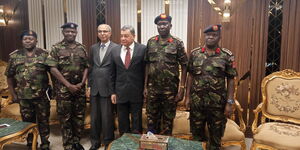In 1987, Kenya chose a rather unusual path when the government decided to use a soap opera to educate members of the public on population and birth control and was endorsed by the United Nations affiliate agency Center for Population Communication International.
This was after statistical reports professed the country's 20 million population to be a runaway problem at the time.
The New York Times on June 14, 1987, reported that the country's population was expected to double by the year 2000 and therefore a need to take action.
As the world population clicked towards the 5 billion mark that year, the United States funded 'Tushauriane' ('Let's Discuss'), a project which aimed to put soap opera at the center of the struggle to flatten Kenya's soaring birth curve.
The project earned a $100,000 funding from the U.S. government's Agency for International Development (USAID). The agency offered to finance the 18-month schedule and a further $300,000 contribution or so to the state-run Voice of Kenya (now KBC) television and radio station.
The project was spearheaded by Kenyan scriptwriter Felix Osodo and director Greg Adambo.
Tushauriane was based on a scientifically researched communication technique developed in Mexico, that used soap operas with social messages to try and alter human behaviour.
A soap opera using the same technique was broadcasted in Mexico between August 1977 and April 1978, and in that period, more than half a million women were said to have begun planning their families for the first time, 32% more than in the previous 12 months. The sale of contraceptives had also climbed significantly.
In Tushauriane, the lives of the characters were developed to be consistent with those of viewers to make the message persuasive and to encourage the audience to identify with the series.
In addition to family planning and health, the melodrama about rural and urban families dealt with such issues as land disputes, intertribal marriages.
Good people who personified positive values were pitted against those who lived on definitions of evil. A third character, like the viewer, battled conflicting emotions.
"This is not, first of all, drama, but value reinforcement," David O. Pointdexter, president of Center for Population communication International stated in an interview with the New York Times.
"We are letting the audience follow the characters in their pilgrimage of searching and finding," Pointdexter stated, "It is a process of behavioral change, and there has got to be a lot of information given," he added.
According to the New York Times, on average, Kenyan families raised eight children and 25 percent of all families were polygamous. The average population growth rate at the time was 4.1 percent.
''Tushauriane' is an attempt to address this urgent national problem combining high quality and attractive drama with a message that families should be smaller," Osodo was quoted by American publication UPI.
Osodo and Adambo, however, had to tread carefully after a television series intended to teach on teenage pregnancy was abruptly taken off air. The action was prompted by viewers' objections to a bedroom scene in which a girl struggled against a boy's advances.
'Tushauriane' was in Swahili, in an attempt to reach a bigger, less-educated audience. But the number of television receivers in Kenya at the time stood at about 220,000. An average of seven people viewed the set regularly, resulting in an audience for the series of only 1.54 million.
To compensate, a parallel radio series was prepared on similar lines. It was much cheaper to produce since it was recorded in Voice of Kenya's Nairobi studio. About 80 percent of Kenyans were thought to have at least occasional access to a radio set.
Interestingly, the proportion of Kenyans that favoured having no more children nearly doubled in the period the programme aired, to 32 percent up from 17.
However, a large percentage of Kenyans from the rural areas still favored huge families, mainly attributed to male attitudes, long-held customs, and religious teachings.












